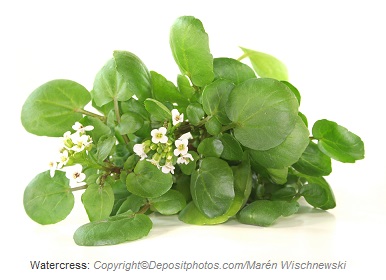Watercress is a green leafy vegetable from Brassica family and closely related to  radish and mustard greens. Two cups of chopped watercress contain 1 gram of carbohydrates, 1.6 grams of protein and 0.4 gram of fiber.
radish and mustard greens. Two cups of chopped watercress contain 1 gram of carbohydrates, 1.6 grams of protein and 0.4 gram of fiber.
Average calories: 8 per two cups, chopped.
|
Watercress: two cups, chopped |
|
|
Carbohydrate |
1 |
|
Fiber |
0.4 |
|
Protein |
1.6 |
|
Fat |
0 |
|
Calories |
8 |
Vitamins found in higher amounts: vitamins A, K, and C. This vegetable is poor in vitamin B group.
Minerals found in higher amounts: manganese, potassium and calcium.
Phytonutrients found in higher amounts and their health benefits: the phytochemicals in watercress are carotenoids and isothiocyanates.
The carotenoids in watercress are beta-carotene, lutein and zeaxanthin. They are powerful antioxidants essential for healthy eyes.
Like other vegetables from Brassica family (broccoli, cauliflower, kale and cabbage), watercress has the phytonutrients glucosinolates and isothiocyanates. Isothiocyanates induce apoptosis (programmed cell death) in certain cancers and can enhance liver detoxification by stimulating both phase I and phase II of detoxifying process. However, the downside of isothiocyanides is that they interfere with uptake of iodine, leading to goiter (enlargement of thyroid gland).
One of the isothiocyanates found in watercress is phenethyl isothiocyanate (PEITC). It acts as a chemoprotective agent and can suppress angiogenesis in certain cancers particularly in lung cancer.
The key glucosinolates identified in watercress in substantial amounts is gluconasturtiian, which can convert into isothiocyanates.
Watercress induces enzyme inhibition. That means this vegetable can inhibit the liver enzyme complex called cytochrome P450, causing interactions with certain medications.

